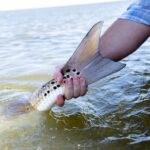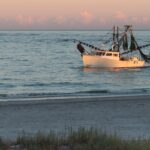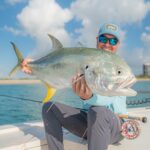
Bowfishing Banned in Biloxi Marsh
Feature Photo: Carter Abramson | Simms Fishing at the Fisheries Science Symposium We have more
By Tony Friedrich
VP/Policy Director American Saltwater Guides Association
The Atlantic States Fisheries Commission met February 5th through the 7th at the Westin Hotel in Crystal City, VA. There are several issues that deserve our attention, concern, and action. There was also some good news for one state.
Let’s start with the positive news. As a result of the recent state elections in New York, a seat at ASMFC has changed. Senator Todd Kaminski is now the Chairman of the Senate Environmental Conservation Committee.
As Chairman, Senator Kaminski assumes the legislative seat for NY at ASMFC. He appointed Captain John McMurray, President of the American Saltwater Guides Association, as his proxy. This is a huge victory for the Association.
You may recall that Captain McMurray was removed from ASMFC only a few short months ago. That action was the catalyst to form the ASGA. John wrote about it here. We are very grateful that Senator Kaminsky recognizes the value of having a healthy ecosystem with enough fish in the water for all.
Senator Kaminski also sponsored a bill to ban purse seining (menhaden reduction fishery based in Reedville, VA) in NY State waters. Earlier in the year, Omega Protein boats fished in federal waters, greater than 3 miles from the coast, in the New York area.
This legislation is expected to pass and displays the Senator’s commitment to our marine resources.
Well, there’s the good news! Now, let’s get on with what happened with striped bass and menhaden at ASMFC.
Striped Bass
On Wednesday, February 6th, the Striped Bass management board met to discuss the current status and future of striped bass. ASGA is doing a “deep dive” article on the striped bass issue. We will get that out soon after this article is published. This is just a report on the meeting.
We have been following this issue very closely and knew the information wouldn’t be good. There were several issues discussed. First, the benchmark stock assessment, then the Maryland circle hook regulations, and finally the Block Island Transit Zone were all covered
The final benchmark stock assessment was delayed due the government shutdown. It should be available the week of February 11th. In lieu of this, the “preliminary” benchmark stock assessment was discussed. At least 4 or 5 times during the meeting, the board was reminded that the numbers would not change very much when the final benchmark stock assessment was presented.
The results were crystal clear. Striped bass are overfished, and overfishing is occurring. The spawning stock biomass (ssb) is the number of spawning age female striped bass in the system. The SSB sits well below the minimum standard. It also means that we are killing them at a rate that exceeds the ability to replenish or rebuild the stock.
There are management triggers that require action under Amendment 6. There are 5 triggers listed on page 31 of the document. Four of them appear to be “tripped”.
Trigger number 3 seems to be the most appropriate to share.
3) If the Management Board determines that the fishing mortality target is exceeded in two consecutive years and the female spawning stock biomass falls below the target within either of those years, the Management Board must adjust the striped bass management program to reduce the fishing mortality rate to a level that is at or below the target within one year.
That means we have to fix the fishing mortality rate, so it is below the target within a year. The SSB currently sits at the same level as 1990, five years before the stock was declared recovered. That means that reductions will be substantial.
A motion passed that tasked the technical committee to report back in May on what it will take to reduce fishing mortality to acceptable levels and provide an example of a size/bag limit/season that would meet this goal.
All this would set up the foundation for an addendum. That process usually takes two meetings. Which means, we could see positive change by the 2020 season.
If you follow these meetings, you know that there are some commissioners that would prefer to not address overfishing and overfished status. We will cover all of this in the “deep dive” striped bass article. For now, just take in this information and know that striped bass are indeed overfished and overfishing is occurring. SSB populations have not been this low for 29 years. Let that sink in.
The Block Island Transit Zone was covered next. As part of a budget appropriation bill, NOAA was instructed to investigate opening the BITZ for striped bass harvest. The BITZ lies well outside the 3 mile line where state waters turn into the EEZ.
At the October ASMFC meeting, the board delayed comment on opening the BITZ until the stock assessment was ready. At Wednesday’s meeting, the board advised against opening the area. It would increase mortality and the stock is clearly overfished. A letter will be written in time to be approved at the next meeting in May.
The Maryland circle hook rule was also investigated. The circle hook rule had absolutely nothing to do with conservation. It was only a way to go from a 20-inch minimum down to 19 inches. The real prize was to move down to 18 inches, the current commercial minimum size. We will get into this is much greater detail in the article to follow. For now, just be aware that Maryland leadership will do just about anything to kill smaller and more fish.
The final numbers showed a slight increase in harvest. There was a six percent uptick with 19” and circle hooks from holding at the 20” minimum. This is an issue to monitor. Recreational discard mortality is a big concern and circle hooks may be a tool used as leverage to mitigate harvest reductions. Science has shown that circle hooks do work. In fact, circle hooks should be mandatory coastwide. However, they should not be used as a tool to lessen harvest reductions.
We will have an in-depth article on striped bass as a follow-up to this report.
Menhaden
Menhaden management is still in a state of flux. The first item reviewed was a review called “Synthesis of Scientific Findings of Atlantic Menhaden’s Role in the Chesapeake Bay Ecosystem”. As a resident of the Chesapeake Bay, the findings were a little disappointing. In fact, they didn’t tell us much of anything. It’s pretty easy to understand that when you remove 100’s of millions of a forage species from a small area, there are serious impacts to the ecosystem. The findings could not show that there is localized depletion of menhaden in the Chesapeake Bay.
As you may recall, Virginia was found out of compliance last year. The legislature did not enact a law that would bring the state’s menhaden regulations into line. However, the proposed cap was not even close to being exceeded in 2018. This raises the question of why not? Why would the Omega fleet steam all the way from Reedville, VA to the federal waters off New York?
ASMFC decided to hold off on the compliance finding until the industry surpasses the cap.
Staff is still working towards Ecological Reference Points (ERP’s). We can expect to see that in 2020. Then, we will have the science to weigh the ecological trade offs between harvesting more menhaden and keeping them in the system
Stay tuned to our new blog. We will post articles and updates frequently.

Feature Photo: Carter Abramson | Simms Fishing at the Fisheries Science Symposium We have more

Each year, hundreds of millions of fish are killed as collateral damage from large-scale, inshore

Feature Photo Credit: Scientific Anglers Team At the heart of the Jack Project is a

Header Photo: Camden Spear Over the past several years, ASGA has consistently championed science-based, precautionary
We rely on our members and donations to keep fighting for a sustainable tomorrow in marine conservation.
GIVE THE GIFT OF FISHERIES CONSERVATION THIS HOLIDAY SEASON. SHOP ASGA GOODS THAT FUND FISHERIES RESEARCH & ADVOCACY CAMPAIGNS
JOIN ASGA IN CALLING FOR CRITICAL MANAGEMENT ACTION AFTER YEARS OF SPAWN FAILURES & POOR MANAGEMENT.
By using this website, you agree to our use of cookies. We use cookies to provide you with a great experience and to help our website run effectively. To learn more, please review our privacy policy.